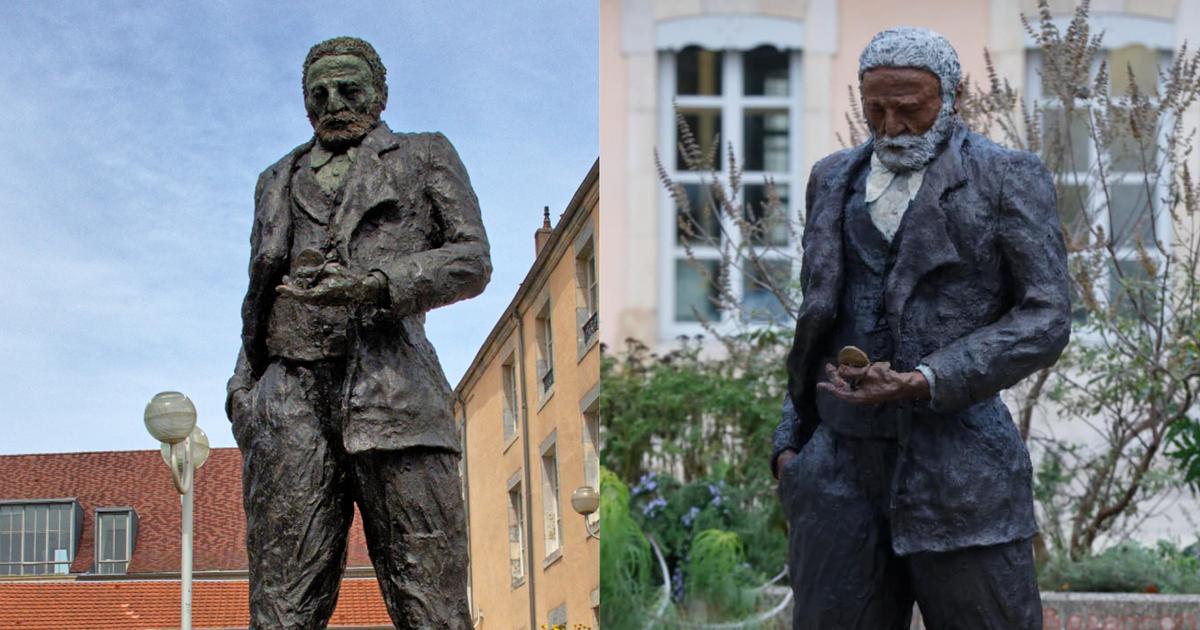From the New York Times news section:
Victor Hugo Statue Takes a Prominent Place in France’s Debate on Race
After a restoration darkened the hue of a statue at the birthplace of the French writer, complaints ensued—then vandalism.
By Catherine Porter
Dec. 31, 2022BESANÇON, France — The statue of Victor Hugo has loomed outside the city hall of his birthplace, situated on the Esplanade for Human Rights, since 2003, his white beard knotty, his black suit rumpled, his face cast down at his pocket watch.
Over the years, the colored bronze began to fade, turning to brown and green, until the mayor’s office recently hired an expert to do a restoration.
And that is when the seemingly unremarkable refurbishment of a statue turned into another controversy in France about race, identity and the importation of American “woke” ideas about racial injustice—what the French call “le wokisme.”
The city hall’s Facebook site announced the statue had been restored to reflect the original work by the celebrated Senegalese sculptor Ousmane Sow, who, it said, liked color and was not keen on “simple bronzes.” The comments rolled in, some positive, others critical with one focus—the color of Hugo’s skin.
“We’ve gone from Victor Hugo to Morgan Freeman,” wrote one commentator.
This being the New York Times, none of the nine photos accompanying the article show what the recent colorization that so many Frenchmen objected to looked like. That would be too interesting. Instead, NYT subscribers want their articles to be blandly reassuring.
But I quickly found a picture and it’s a doozy. From News in France, here’s the statue before and after its colorization:

But you can’t show a picture like that in the NYT because it would be counter-Narrative.
It appears that the foundry (or somebody) decided to colorize the two-decade-old statue of Hugo to make it look like the African sculptor. Here’s the late sculptor with his original version:

But here’s what it looked like after it was recently colorized:
Mr. Sow, who was often called the Auguste Rodin of Senegal, died in 2016. A reporter from the Besançon newspaper called Béatrice Soulé, Mr. Sow’s widowed partner in Dakar, Senegal’s capital.
She agreed that the restoration was flawed, saying that the statue “looks like a Black Victor Hugo, which was never Ousmane’s intention.”
In a later interview with The New York Times, Ms. Soulé said that perhaps she spoke too freely. “It was a sentence I should never have spoken,” she said. “And it let off a powder keg.”
I am fascinated by how the reporter from the New York Times evidently chastised the widow for having previously given a clear, honest quote instead of appropriately obfuscated wokeness. Traditionally, reporters try to get interview subjects to give them truthful and vivid quotes. But in 2022, the NYT prefers that the people they interview try to walk back their truthful and vivid quotes when what they said undermines The Narrative.
After another attempt at restoration, the color of the statue was returned to what Ms. Soulé considered “magnificent” and an “exact replica of the original,” which reflected a man of light-brown skin. But what might have been forgiven as part of a complicated restoration process—and quietly corrected—was immediately sucked up into an ugly, protracted battle over social media.
What did Victor Hugo actually look like? Did he have ”light-brown skin”?
Wasn’t there a famous 19th-century French bestseller author who was part black from Haiti?
Yes. Yes, there was.
But—and follow me closely here—that writer wasn’t, technically speaking, Victor Hugo, author of The Hunchback of Notre Dame. It was, instead, Hugo’s friend and rival Alexandre Dumas, author of The Three Musketeers.

So, by process of association, that must mean Hugo was sort of a mulatto too.
Except, he wasn’t. In contrast to Dumas, here’s an 1825 painting of Hugo at age 23:
Am I accusing the New York Times of having gotten Hugo and Dumas a little bit confused?
Right-wing politicians accused the city’s Green party mayor of literally trying to paint her politically correct views onto a French hero.
“Just how far will #wokisme and stupidity go?” Max Brisson, a senator with the center-right party, Les Républicains, wrote on Twitter.
National radio and newspapers picked up the story.
The town hall’s switchboard was flooded by so many furious calls it was shut down.
Two nights after the town hall’s initial Facebook post, masked men vandalized the statue, repainting Victor Hugo’s face “a beautiful white color,” as they called it online, adding that it was now “truly French, truly from Besançon.” On the photograph they took of their work, they added a Celtic cross and the words “white power.”
In English. Even in France when it comes to a French literary titan, protesters write their slogans in English for the American news media’s cameras.
Unlike in the United States and other Western countries, statues in France were never toppled after George Floyd’s murder in 2020 in Minneapolis and the global Black Lives Matter protests that ensued. President Emmanuel Macron of France rejected the idea, stating instead that the country would “look at all of our history together with lucidity.”
However, many high-profile intellectuals, academics and members of Mr. Macron’s government have viscerally rejected the progressive systemic theories on race, gender and post-colonialism as American imports that undermine French society, which considers itself colorblind.
“We are in denial of our colonial history,” said Fabrice Riceputi, a historian in Besançon who specializes on the country’s troubled colonial history in Algeria, which ended 60 years ago after a brutal war of independence that left 500,000 dead by French estimates, and 1.5 million by Algerian ones.
These rightwing racists are trying to cover up the fact that Hugo’s grandparents were born in the colony of Haiti.
Oh, wait, let me check Wikipedia first. Huh, what do you know? That was Dumas, not Hugo.
Never mind.